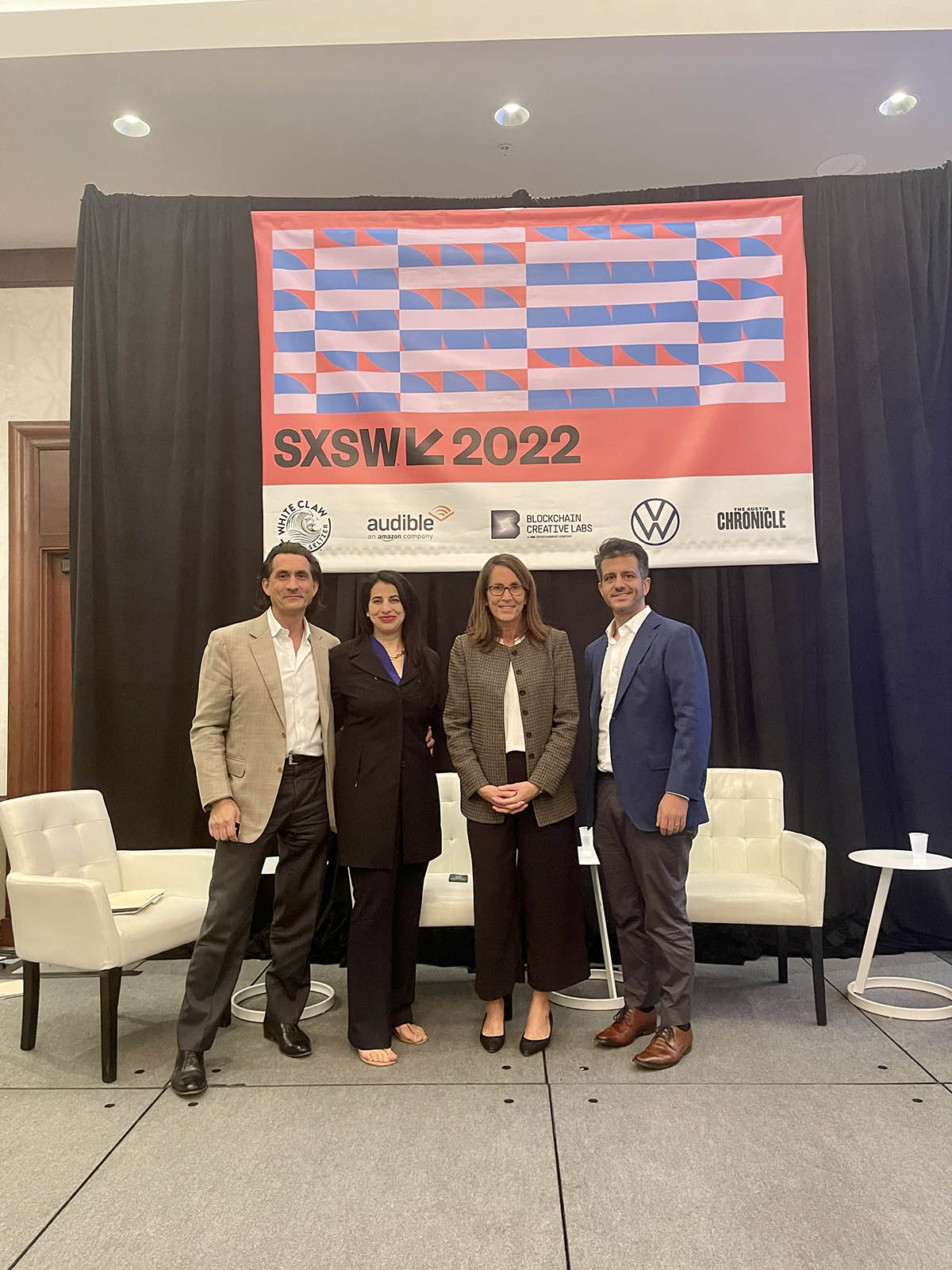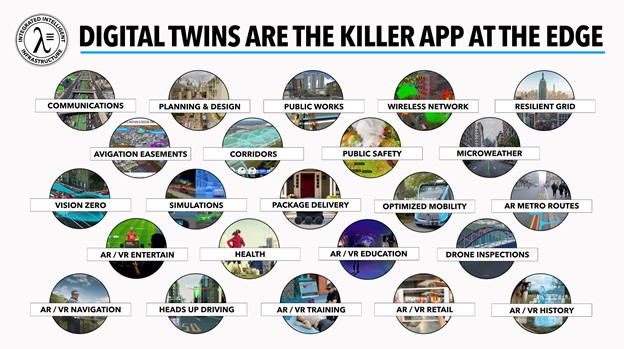SXSW 2022: Digital Twins: Industry 4.0 and the Automated Future – Panel Highlights
Digital twins – veracious, physics-based 4D digital representations of the roadways, vehicles, traffic signals, weather, and more
April 12, 2022
EDJX and Autonomy Institute combined forces at this year’s SXSW to present a panel on the new Transportation track which featured earlier in the week a keynote by Secretary of Transportation Pete Buttigieg, and the Deputy Assistant Secretary and CSO Dr. Robert Hampshire-led panel discussion, ‘Putting Transportation Equity in the Fast Lane.’
“Transportation – Walking, cycling, driving, trains, flying, scootering these days – and so many other modes of transportation…are all ways that affect our lives on a daily basis,” said Senior Director of Conference Programming Monica Sack in her introduction to Secretary Buttigieg, “Transportation is one of the most important aspects of our lives.”

The panel discussion on Digital Twins: Industry 4.0 and the Automated Future included Jeffrey DeCoux, Chairman, Autonomy Institute, Night Keyes, President, Eagle Lake Development, Patricia Baumhart, Emerging Tech Strategist at National Security Corporation, and Moderator Laura Roman PhD, CMO, EDJX. The panel delved specifically into how Traffic Management is achieved through integrated, interactive systems. Digital twins – veracious, physics-based 4D digital representations of the roadways, vehicles, traffic signals, weather, and more – model these system interactions. These digital representations enable the processes for getting the right data to the right people at the right time for quicker collaboration and decision-making across diverse functional teams. The broader context of Digital Twins – the “killer app at the edge” – and Traffic Management is Industry 4.0 and the automated future – how Intelligent Infrastructure, Data Exchange, and Digital Twins are the way forward for government and industry leaders pursuing greater efficiency and autonomy at a scale that is Industry 4.0 – the future.
Industry 4.0 and Digital Twins – the Killer App at the Edge
Jeffrey DeCoux, Chairman of Austin-based Autonomy Institute, a cooperative research consortium focused on advancing and accelerating Intelligent Infrastructure and autonomous systems, opened the discussion with level-setting definitions of Industry 4.0 and digital twins. Industry 4.0, the pursuit of greater efficiency, automation, and autonomy at scale, is the vision of a future marked by technological breakthroughs—Robotics, AI, extended reality, nanotech, decentralized decision-making, and autonomous machines. Intelligent Infrastructure is the foundation of the smart city and the building block of Industry 4.0. The same Infrastructure that enables Industry 4.0 has an immediate impact on cities’ goals today; advance Vision Zero, eliminate the digital divide, stimulate economic expansion, deploy a terrestrial APNT platform, activate micro-grids, electrify mobility, and national security, and job growth.
There is a data tsunami tied to the increasingly growing number of IoT sensors and endpoints sprouting at the edge. Intelligent cities will depend on creating “Data-Exchanges,” a sovereign database of all the information collected by the city’s IoT systems and sensors. The Data-Exchange will allow secure, private, and transaction sharing of valuable data assets with trusted and approved partners. Intelligent Infrastructure will enable developers to access the data and develop applications that will leverage the data. Computing in the era of IoT is moving out of the realm of the abstract and into the real world to power augmented reality, empower decision-making via AI and machine learning, operate cars, and increase public safety. The future of computing is at the edge, processing data where it is generated, enabling immediate insights that will inform decisions. Next-generation applications and services require a new computing infrastructure that delivers low-latency networks and high-performance computing at the extreme edge of the network.
Futurist Bernard Marr described a digital twin as “an exact digital replica of something in the physical world; digital twins are made possible thanks to IoT sensors that gather data from the physical world and send it to machines to reconstruct.” Unstructured data, such as IoT technology, have made digital twins possible—and these digital twins can solve real-world problems in virtual universes. Digital Twins, as the killer app at the edge, are a way to illustrate, understand complex systems, and translate the physical world into the digital world, enabling us to visualize today and simulate tomorrow. There is a broad range of applications and use cases for Digital Twins – not just for engineers. With a digital twin in place, government agencies can effectively analyze what can be done with the data and improve citizen living, create economic opportunity and revitalize a closer community. And why Digital Twins are the killer app at the edge. Digital Twins require a new infrastructure that is intelligent Infrastructure. Integrated intelligent Infrastructure provides for economic growth, connecting the unconnected and national resilience in the new digitized age.

Digital Twins and Traffic Management
Night Keyes described the future of Transportation and explained the role of Digital Twins as applied to Transportation and traffic. Digital Twins in traffic management help to get the right data to the right people at the right time for quicker collaboration and decision-making. When applied to traffic management – or more broadly, Transportation – Digital Twins allow for the georectifying of data – rendering an ever-shifting location point in real-time. Traffic fatalities are a national crisis – According to the U.S. Department of Transportation, last year, 2021 traffic fatalities were at an all-time high: there were over 30,000 car-crash deaths in the U.S. in the first nine months of 2021, a 12% surge that marks the most significant increase in fatalities since reporting began nearly half a century ago. Pete Buttigieg states, “People make mistakes, but human mistakes don’t always have to be lethal. In a well-designed system, safety measures make sure that human fallibility does not lead to human fatalities.” We need to create the environment to translate the physical world into digital space. The Digital Twin becomes the translation that enables these systems to be widely understood by the machines and people navigating across them. This is key to achieving the goals of Vision Zero. This international movement aims to reduce traffic deaths and life-changing injuries to zero while increasing safety, healthy, equitable mobility for all. We need a mastery of the streetscape to have the necessary ubiquitous situational awareness – digital twins deliver this “streetscape” view. Digital Twins create the mapping of the streets and highway corridors to help us design more efficient, more effective, and more equitable transportation systems.
Night Keys also spoke to a critical part of achieving the goals of Vision Zero and optimizing transportation flow generally is the role of public-private partnerships, or P3s, which speed up innovation by opening new funding opportunities and applications. The approach is based on partnerships – many across the nation – that include private infrastructure investors, government agencies, solution providers, universities, and most importantly, the communities the P3s are serving.
Data Exchange and Privacy at the Sensor
“Data is the key resource of the 21st century.” Patricia Baumhart, building on Brigadier General (ret.) Robert Spalding’s quote addressed data as a powerful tool and critical to finding the patterns, insights, or behavioral signals that can inform improved systems operations and city services or might signal a vulnerability in the organization’s protection stance or even a cyberattack underway. Yet, those benefits have led us to a new problem: we are now drowning in data!
A simple and often overlooked solution is to understand precisely what data we’re collecting, why we’re collecting it, and how we plan to use it.
Digital Twins become the framework for data exchange. Data exchange takes data structured under a source schema and transforms it into a target schema so that the target data is an accurate representation of the source data. Data exchange allows data to be shared between different computer programs. In other words, digital twins become a data repository and the software stack that enables transactions. Autonomy Institute is solving the financing and the infrastructure deployment and will solve for data to benefit the community it serves. This requires a new approach to data and a new business model. Data is used for the purpose required at the edge (e.g., for pedestrian, driver, and passenger safety at an intersection or on a highway corridor) and is governed by and sovereign to the P3. Any revenue derived from the data is allocated per the P3 agreement.
Privacy at the sensor entails advancing the next generation of US infrastructure while prioritizing individual privacy protections. The next generation of infrastructure should be designed and built to be resilient, energy-efficient, and integrate harmoniously with network communications, autonomous vehicles, and other “smart” systems. Emerging civic technologies — such as sensors, computers, and software that can support billing and payment, manage public resources, monitor the integrity of structures, track traffic flows, and more — can improve the performance of future infrastructure and improve community livability. However, the public often believes that civic technologies invade individual privacy and enrich tech companies. Public distrust has disrupted multiple civic-technology projects around the world.
Privacy at the sensor entails a radically different approach – decisions at the edge, zero trust. Investing in a suite of research and development activities to develop new, sensor-based civic technologies that inherently preserve privacy in a manner verifiable by citizens is an imperative. Investing in complementary activities to promote the adoption and acceptance of such “privacy-at-the-sensor” technologies is also essential.
In summary, people are coming together to collaborate and jointly use their creativity and knowledge to build strong, productive communities. Self-sustaining, thriving, socially-connected communities that solve problems together and benefit from new forms of digital revenue from a digital ecosystem that is Industry 4.0. As the killer app of the edge, Digital Twins are the conduit.
A collaborative approach to “shovel worthy,” dig-once, Intelligent Infrastructure will build resilient communities, stimulate economic growth, advance vision zero, create millions of jobs, eliminate the digital divide, increase national productivity, secure our supply chains, secure our national sovereignty and most importantly enable Industry 4.0.
Join us back in Austin for the Intelligent Infrastructure conference on April 28-29, happening at the Fairmont Hotel. Click for information and register here.

